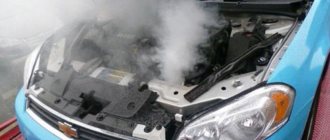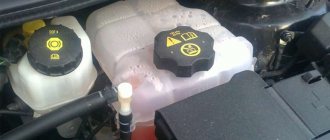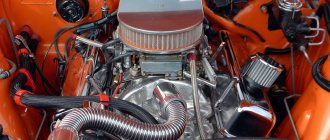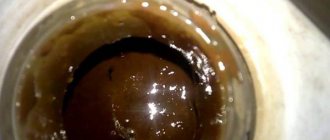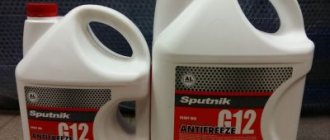Antifreeze or antifreeze is a working fluid that is designed to circulate in the circuit of the engine liquid cooling system. An insufficient level of coolant (coolant), a significant loss of its properties, air entering the system and other malfunctions lead to the fact that the engine does not operate at the optimal temperature for the power unit.
We also recommend reading the article about the difference between antifreeze and antifreeze. From this article you will learn about the main differences between these types of coolant for the cooling system.
An antifreeze leak is a common problem that requires immediate attention. The fact is that even a minor leak can suddenly develop into a serious leak. As a result, the engine can quickly overheat, which leads to serious consequences for the motor. For this reason, it is important to find the location of the leak and eliminate the antifreeze leak in the cooling system. In this article, we will look at where antifreeze can leak from, talk about how to find an antifreeze leak, and also answer the question of how to fix leaks.
How to determine if there is an antifreeze leak
If the temperature indicator reports that the engine is heating to a critical level, this may be an indirect sign that the coolant is leaking and is not able to quickly remove heat from working components and parts. However, there may be other reasons for overheating. For example, a faulty water pump or air trapped in the cooling system. Therefore, it is first recommended to carefully inspect the car for the following signs of a possible antifreeze leak:
- there are puddles and stains of liquid under the car;
- the level of antifreeze in the expansion tank drops;
- stains of oily liquid are visible on the interior floor;
- white smoke comes out of the exhaust pipe;
- the car heater is unstable;
- the engine often overheats;
- steam comes from under the expansion tank cap;
- There is a smell of antifreeze in the cabin.
Obvious reasons for loss of antifreeze
If your dashboard temperature indicator shows a high temperature, it could be a sign of a coolant leak. The temperature sensor monitors the coolant temperature. If there is a leak, it means there is less coolant in your system to keep your engine running smoothly. The remaining amount of antifreeze must now absorb more heat per unit volume, resulting in a higher coolant temperature.
The first step is to check if there is a coolant leak and then determine how serious it is. Some leaks originate from various parts of the cooling system and allow antifreeze to drip onto the engine or the ground underneath. Other leaks may occur internally and require other detection methods.
Cooling systems are installed with an expansion tank, from which antifreeze can also escape. It connects to the radiator. There is additional antifreeze in the tank that can expand or contract as the engine heats up and cools down. This ensures that sufficient quantities of the substance are available under all conditions. The expansion tank is also located where you can check and top up the coolant level at any time. There are marks on it showing the minimum and maximum coolant levels.
To check your car's coolant level, park it on a level surface and check it when the engine is cold. The level in the tank should be between minimum and maximum. If it is below the minimum, replenish it with a mixture of 50% antifreeze and 50% distilled water. You can mix it yourself or purchase pre-mixed coolant.
Now that you have established a baseline coolant level, check it every day to see if there are any changes. If the level drops significantly, add fluid and contact your mechanic immediately - you have a major leak. To get started, do the following:
- Checking under the car. If you see green or orange fluid underneath your engine on the floor of your garage or parking lot, it's most likely a sign of an antifreeze leak. You may also notice a sweet smell when you get out of your car after using it - this may indicate antifreeze is leaking onto hot engine parts. Another good way to determine the amount and location of an external antifreeze leak is to place a large piece of cardboard under the engine when you park car for the night. In the morning, check how much antifreeze has leaked and where it comes from - this can be very useful information that will help you get rid of the problem as soon as possible.
- Check under the hood. Do this when the engine is cold and the car is turned off. Open the hood and check for signs of coolant leaks. Use a flashlight and check for leaks or drips coming from the radiator, cracks or moisture in the hoses attached to the top and bottom of the radiator, smaller heater hoses and their connections. Traces of corrosion and rust can also be found in places where the radiator leaks. Check the part of the engine where the belts are installed - this is where the water pump is located and may be the main cause of antifreeze leaks. Inspect and tighten any hoses you can get - they should be strong and free of cracks. Also inspect the engine from all sides for antifreeze leaks - the cause of this may be its head.
- Start the engine. Let it warm up, turn it off and check all areas again for antifreeze leaks, trying to stay away from hot engine parts. Some coolant leaks will only occur when the cooling system is hot and under pressure. Check the radiator (especially along the seams), pipes, connections and other places listed above. Wear safety glasses or a mask to protect your eyes.
Why does antifreeze leak?
The cooling system of a car engine includes a number of components and connecting pipes. Any defects associated with leakage lead to antifreeze leakage. Problems are usually caused by:
- natural wear and tear of parts;
- assembly errors during repairs;
- external mechanical damage;
- gross violations of operation, etc.
it is important! One of the main signs that antifreeze is leaking is a rapid decrease in its level in the expansion tank. It should be remembered that the slow decrease in the volume of coolant in the summer is caused by the constant evaporation of the water included in its composition. To compensate for the coolant level, topping up is enough. If the volume of liquid decreases quickly during the cold season, it is necessary to do a visual inspection of the car and find out where and why the antifreeze is leaking. Checking the cooling system is carried out only after the engine has cooled down. If this rule is not followed, you can be seriously burned or injured during work.
What are the consequences of a lack of coolant in the cooling system?
The coolant in a car plays a very important role. During operation, the engine becomes very hot. Especially in winter, in cold weather, or when operating at maximum speed and power. This can also happen when the radiator is clogged or the thermostat is broken.
Overheating can damage the engine. Therefore, a liquid cooling system was invented. Here's how it works: antifreeze washes the running engine, cools it and heats itself up; passing through the radiator, the liquid gives off heat to it, and itself cools down and goes to the next round. The radiator fins, in turn, cool quickly.
Therefore, the absence of coolant or its lack is fraught with the fact that the internal combustion engine will overheat greatly, break down and fail. This is why monitoring the antifreeze level is no less important than monitoring the fuel or engine oil level. And in case of leaks, fix them immediately.
How to find a leak
Leaks in pipes, radiator, and other connections of the cooling system are often detected during the initial inspection. For example, antifreeze may drip or leak, causing wet spots. If a visual check does not allow you to localize the place where the coolant is flowing from, it is necessary to sequentially check all components and connections of the cooling system.
Cooling system radiator . Large temperature changes cause thermal fatigue processes in the main heat exchanger, which leads to the formation of microcracks on its surface. Due to constant contact with liquid media during operation of the radiator, pockets of corrosion appear on its body. In addition, the product receives mechanical damage, for example, as a result of stones falling while the car is moving. All these defects cause antifreeze leakage, which can be seen in streaks on the body or in puddles under the car. If such a breakdown occurs on the road, the best way to fix it is to use a sealant. This material has an emergency purpose and can help out in an emergency. In a car service center, radiators are repaired using soldering or argon-arc welding. If the damage is too deep, it is better to replace the used heat exchanger with a new one.
Expansion tank . Antifreeze can leak from under the cap, through cracks and cracks in the body. Sometimes it happens like this: the surface of the tank is wet, oily, and there is no visual damage. This indicates the presence of microcracks that are invisible to the eye. Therefore, you should replace the housing and/or cover with new, serviceable ones. If you are not sure that it is the expansion tank that is leaking, you should first send the car for diagnostics to a workshop or service center.
Connection points . To check their tightness, drivers often use a simple but quite effective method: a sheet of paper is placed under the car, after which it is left in the parking lot for some time. The appearance of coolant stains indicates the need for a thorough inspection of pipes and hoses, especially their connections to other components of the system. You should also check the thermostat seals, as antifreeze may leak out from under the thermostat gasket or through damage to the housing. In this case, a complete replacement of faulty components and parts is carried out.
Rubber pipes . They operate under a constant temperature difference, which over time leads first to the appearance of microcracks and then to cracking. Such a defect in the pipe does not cause a serious leak; antifreeze leaks out slowly. However, the product must be replaced with a new one. When checking the pipes, they should not only be inspected, but also carefully felt to find subtle cracks. A mirror can be used to visually inspect hard-to-reach areas. It should be remembered: the reason that antifreeze is leaking may not be so much the pipe as a poorly tightened clamp at the junction with the fitting. Often, more tightening is enough to stop the leak.
Pump (cooling system pump) . It is one of the most common places for antifreeze leaks, along with the pipes and expansion tank. Typically, coolant leaks out due to loss of tightness of the stuffing box seal. It is easy to locate the leak: antifreeze flows down the pump rod and then splashes onto nearby parts. If this is the problem, it is recommended to immediately send the car to a workshop, where they will diagnose it and immediately replace the pump. This urgency is due to the fact that on many cars the pump is controlled by a timing belt (gas distribution mechanism). Therefore, unresolved problems with the pump often lead to more serious damage to the car.
Stove (heating) radiator . Clear signs that coolant is leaking from there will be a constant smell of antifreeze in the car interior and heavy fogging of the windshield windows. With more serious radiator leaks, coolant stains appear on the floor (usually in front of the front passenger seat).
You might be interested in: Why does antifreeze “leave” from the expansion tank?
How to fix a leak
If the cause of the leak is a crack in the tank, then it is necessary to replace it or at least repair the crack. Small leaks can be temporarily repaired by adding a special additive to the antifreeze reservoir. It acts as a plug for small holes and cracks. However, this is for emergency cases when it is not possible to fix the problem in the near future at a car service center. Over time, this additive will begin to settle in different parts of the cooling system, deteriorating the properties of antifreeze. Another temporary solution - if the problem is in the pipes and their tightness - is a special sealant. However, it is only used in emergency cases! It is better not to resort to this method.
The only way to get rid of the problem is to replace the broken parts. It is best to change the hoses and pipes, the thermostat and water pump gaskets, as well as the thermostat and pump itself. You can deal with this on your own.
In case of more serious breakdowns, not everyone will be able to cope on their own. This requires not only special tools, but also experience and knowledge of the car's structure. Therefore, in many cases it is wiser to contact a car service.
How to find the leak
To determine the location of the antifreeze leak, a variety of methods are used - from routine inspection to the use of special devices and additives to the coolant. Diagnosis proceeds from simple to complex. If you can detect the leak visually, you can immediately proceed to repair. But this is not always the case. On many modern cars, parts and components are located so compactly that it is difficult for the driver to see where the coolant may be leaking from. In these cases, various auxiliary means come to the rescue.
Fluorescent additive in antifreeze . Using this original method, you can not only quickly find the location of the coolant leak, but also eliminate the damage. The method consists of adding a special fluorescent composition to the antifreeze, which can be bought on the market or in a car dealership. After starting the engine, the suspected leak location is illuminated with an indicator (UV) lamp. In this way, it is possible to establish a hidden leak or leakage of liquid in small portions when visual diagnostics do not produce results.
Pump with pressure gauge . Using such equipment, you can check the integrity of the expansion tank. To do this, the tank is dismantled and a pressure of about 1 atm is created inside it. If the pressure gauge readings remain stable for a long time, the leak needs to be looked for elsewhere. At the same time, you can check the condition of the valve: it is important to remember that on modern cars it is set to a pressure of 2 atm. The same can be done without removing the tank. When experiencing excess pressure supplied to the system, the leak will manifest itself faster.
How long can you drive a car without antifreeze?
The leakage of antifreeze indicates the beginning of critical and irreversible changes in the operation of the vehicle. But the consequences are not immediately noticeable, so you have a short period of time to get home.
Perhaps you will have time to get to the service station. It must be taken into account that in winter the engine will be cooled due to external conditions and therefore will be able to work longer. In summer, the critical situation will be resolved faster.
In addition, the ability to drive without antifreeze is affected by the general condition of the engine. The design, which is characterized by low mileage, will last longer than the old engine. According to statistics collected by car owners, you can drive a car without antifreeze for about 1 km. The data may differ in one direction or the other, depending on the characteristics of the vehicle.
Cleaning and temporary system repairs
In some cases, the cause of an antifreeze leak may not be damage or excessive wear of individual parts and components. Sometimes the coolant begins to decrease after cleaning the internal surfaces of the equipment with various special means. Performing their direct function, such products remove dirt, scale and rust, which can heal small cracks in the elements of the cooling system. If this happens, a temporary solution to the problem may be the use of additives that are added to antifreeze to eliminate leaks.
Where else can antifreeze go if there are no leaks?
It happens: all the parts are new or the car has just been repaired, but the inspection does not yield results - not a trace of a leak is visible. However, it still seems that there is less antifreeze.
Interesting! If there is really nothing wrong with the car, there is no need to worry. Any liquid - and antifreeze is no exception - evaporates over time. More precisely, during operation, the water included in its composition evaporates, and all salts remain in place. Therefore, it is recommended to add a little clean distilled or demineralized water as it evaporates. These losses are small – usually up to 10%. If a lot of antifreeze leaves, it means that something is really wrong, you just haven’t discovered the leak yet.
And at sub-zero temperatures, antifreeze contracts and decreases in volume, so after a cold night it may seem like there is less of it. When the engine warms up, the volume will return to its previous values.
Which antifreeze leaks are difficult to detect visually?
In some breakdowns, the coolant does not pour out, but seeps into the internal components. Usually the cylinder block (BC) or its head (cylinder head) suffers from this. Indirect signs of antifreeze getting into this unit are as follows:
- When checked with a dipstick, the oil has a different color: sometimes too light, sometimes very dark;
- exhaust gases become white, similar to steam, and very often have the smell of antifreeze;
- The coolant level drops slowly and steadily. This does not mean that the coolant goes specifically to the BC unit, but it is very likely;
- Spark plugs (one or more) may be wet, oily, or smell like antifreeze.
There may be several reasons for coolant leaking into the cylinder block. The most common problems are three.
Burnout (breakdown) of the cylinder head gasket . This part ensures the tightness of the connection between the cylinder block and the head, separates the combustion chamber and the cooling channels through which antifreeze circulates. The standard causes of burnout/breakdown of the cylinder head gasket are:
- engine overheating;
- abnormal tightening of cylinder head bolts;
- ill-conceived engine power tuning;
- the use of low-quality gasoline, which causes detonation.
To restore tightness, it is enough to replace the cylinder head gasket. Its cost is relatively low, especially for domestic cars. The most difficult operation will be removing and installing the cylinder head. To do this, torque wrenches must be used that allow the tightening forces to be set for each specific vehicle. If the head is deformed, then it will also need to be replaced.
Linear cylinder head defects . If the plane by which the head is pressed to the cylinder block is uneven, the fit will not be tight and antifreeze will leak out. Such cracks are invisible during visual inspection. An experienced driver determines the unevenness of the cylinder head by placing the ruler edge-on on the plane. The best option to correct the problem is to visit a car repair shop, where defects in the cylinder head surface will be eliminated by grinding.
Cracks in the cylinder block (BC) or its head (cylinder head) . This problem is the most serious. If such a defect occurs in the lubrication and cooling channels, the coolant may leak into the cylinders of the internal combustion engine, where it mixes with the engine oil. This not only reduces the amount of antifreeze in the cooling system, but also deteriorates the properties of the lubricant. The most common way to eliminate cracks in the body of a cylinder head or cylinder head is welding. This operation must be performed by qualified craftsmen using specialized equipment. If the damage is severe, the cylinder block may be beyond repair and will require complete replacement.
Consequences of a coolant leak
Engine operation with low antifreeze levels causes a number of problems that affect both the comfort and reliability of the vehicle:
- Insufficient coolant makes the interior heater ineffective. Often, heat only appears from the air ducts when the engine speed increases.
- Due to ineffective cooling, the engine begins to operate at elevated temperatures, which can lead to engine failure.
- As a result, the remaining coolant will boil, which is often accompanied by rupture of pipes and radiators.
This is interesting: How to adjust the side door on a Gazelle?
In any case, the cost of repairs is tens of times higher than the price of a 10-liter canister of antifreeze, and even if the car owner does not have time to send the car to a car service center, monitoring the coolant level and adding it is simply necessary.
Let's sum it up
If the driver determines that the car has an antifreeze leak, but cannot independently determine what caused it and/or fix the problem, you should visit a service center. Specialists carry out diagnostics and carefully check the entire cooling system for correct operation. After determining the cause of the malfunction, it is eliminated: the part or assembly is repaired or replaced. To make it easier to solve problems associated with antifreeze leaks, it is recommended:
- use coolants with the addition of fluorescent pigments. The latter are sold separately and can be added to a tank with already filled coolant;
- Do not add water to antifreeze in winter. This leads to a decrease in the concentration of the main substance and freezing of the coolant in the channels of the cooling system, which entails significant problems in the operation of the car.
#Trouble-shooting
What is the danger of leakage?
There are two main dangers that arise from an antifreeze leak:
- A leak of antifreeze inside a car poses a health hazard to passengers and the driver. Refrigerant vapor poisoning may occur.
- Overheating will cause the car's engine to fail prematurely.
Also, do not forget that if the antifreeze level has decreased, do not add plain water. This can have dangerous consequences. Buy coolant only from trusted and reliable manufacturers
. Remember that you should not mix different brands of coolers, because they can often be incompatible.
To ensure that you do not make a mistake when choosing antifreeze, carefully read the instructions for the engine of your particular car. Follow the advice of experts, and you will be able to extend not only the life of your car, but also protect yourself and passengers from vapor poisoning and deterioration of health.
You may also be interested
Why antifreeze leaked, causes of leakage and what to do
An insufficient level of antifreeze leads to overheating of components and parts and disruption of the optimal temperature regime. Therefore, if a leak is detected, the problem should be addressed immediately. Otherwise, this can lead to serious consequences for the engine.
Why the interior may smell like antifreeze: several serious reasons
Many motorists have encountered the unpleasant situation of smelling antifreeze in their car. Why is this happening? How dangerous is the situation for the car and its owner, how to fix the problem? Let's talk to the experts.
Ways to temporarily solve the problem with the cooler
A situation where antifreeze leaks and you get to the service station in a matter of minutes is the best-case scenario. But what to do if you need to temporarily solve a problem with the coolant, since there is no auto repair shop nearby and you can’t get to your home.
Tips and tricks:
- You can fill the radiator with distilled water;
- no need to plug the radiator pipes;
- if the engine is too hot, you should turn off the engine and wait until it cools down;
- you can try to top up the antifreeze in the hope that it will not leak out before you get to the car service center.
All of the above methods are temporary solutions. The car needs diagnostics and repair. Experienced technicians will be able to detect leaks only during a detailed inspection. In most cases, it is necessary to eliminate the cause that led to depressurization.
Hot
If the leak appears only on a hot engine, the reasons will be completely different. Most often you can find one of these problems:
- Damage to the rubber hose. While the fluid is cold, it does not leak, but when it heats up, the material of the pipe becomes softer and allows coolant to pass through. Most often these are quite small cracks.
- The antifreeze reservoir or other element is leaking in a place just above the fluid level. It happens that the damage is located above the coolant level, but when heated, the volume increases and a leak occurs.
- Poor condition of seals. If the element does not fit very securely, then the integrity of the system can be ensured when cold, but as it heats up, the pressure increases and the antifreeze is squeezed out.
By the way!
There is another problem in Lada Prioras: coolant leakage from a plugged technological hole in the lower part of the engine. Over time, the plug rusts or its seal deteriorates and fluid leaks out. It is difficult to detect the problem, since it is hidden under the timing belt cover and it is not clear where the antifreeze is leaking from under the engine.
